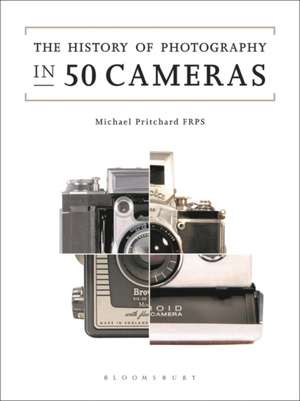The History of Photography in 50 Cameras
Autor Michael Pritcharden Limba Engleză Paperback – 23 sep 2015
As well as placing each model in its historical context, the book describes the people who created and used them and the kind of photos they produced, from Weegee and his Speed Graphic to Cartier-Bresson and the Leica's role in the invention of photojournalism.
Preț: 108.64 lei
Preț vechi: 173.19 lei
-37% Nou
20.79€ • 21.70$ • 17.20£
Cartea nu se mai tipărește
Specificații
ISBN-10: 1474250602
Pagini: 224
Ilustrații: 150 colour illus
Dimensiuni: 170 x 227 x 22 mm
Greutate: 0.59 kg
Editura: Bloomsbury Publishing
Colecția Bloomsbury Visual Arts
Locul publicării:London, United Kingdom
Caracteristici
Notă biografică
Dr Michael Pritchard FRPS was a photography specialist and Director at Christie’s, London, UK, for over twenty years and is currently Director-General of The Royal Photographic Society, UK. He created and edits the popular and respected blog, British Photographic History (britishphotohistory.ning.com).
Cuprins
Introduction1. Talbot ‘Mousetrap’ Camera (1835)2. Daguerreotype Camera (1839)3. Ottewill Collapsible Camera (1853)4. Sutton Panoramic Camera (1859)5. Enjalbert Photo-Revolver de Poche (1882)6. Rouch Eureka Detective/Hand Camera (1888)7. The Kodak Camera (1888)8. Stirn Vest Camera (1888)9. Scovill Book Camera (1892)10. Goerz Anschutz Camera (1894)11. Thornton-Pickard Royal Ruby Field Camera (1895)12. Brownie Camera (1900)13. Sanderson Hand Camera (1904)14. Soho Reflex Camera (1905)15. Ticka Camera (1906)16. Vest Pocket Kodak (1912)17. Thornton-Pickard Hythe Camera/Gun (1917)18. Voigtlander Prominent Camera (1932)19. George Washington Kodak Camera (1932)20. Zeiss Ikon Contax I Camera (1932)21. Canon Hansa Camera (1935)22. Leica I Camera (1935)23. Coronet Midget (1935)24. Kine Exakta Camera (1936)25. Minox Camera (1937)26. Compass Camera (1937)27. Kodak Super Six-20 Camera (1938)28. Eastman Kodak Co, Matchbox Camera (1944)29. Zeiss Ikon Super Ikonta 533/16 (1948)30. Polaroid Model 95 Camera (1948)31. Hasseblad Camera (1948)32. Speed Graphic Camera (1950)33. Viewmaster Personal Stereo Camera (1952)34. Leica M3 Camera (1954)35. Nikon F Camera (1959)36. Rolleiflex 2.8F Camera (1962)37. Topcon RE Super Camera (1963)38. Kodak Instamatic 100 (1963)39. Pentax Spotmatic Camera (1964)40. Olympus OM1 Camera (1972)41. Kodak 110 Instamatic (1972)42. Polaroid SX-70 Camera (1972)43. Canon A1 Camera (1978)44. Sharp J-SH04 Camera/Phone (1980)45. Sony Mavica (1981)46. Fuji QuickSnap Camera (1986)47. Canon RC701 (1986)48. Kodak / Nikon DCS100 (1991)49. Apple Quicktake Camera (1994)50. Camera-phone (2013)GlossaryBibliographyIndexCredits
Descriere
The history of photography, perhaps more so than any other art, is a history of technology that is best revealed in the very vehicle that makes it possible – the camera. Through a selection of fifty landmark cameras, Michael Pritchard tells the story of this ground-breaking piece of equipment that changed the way we saw the world around us. Beginning with Louis Daguerre’s daguerreotype of 1839, other entries include the Brownie (1900), the Kodak Instamatic 100 (1963), the Polaroid SX-70 (1972), right up to the Canon EOS 5D Mark III (2012) and the Nokia Lumia camera phone (2013). Illustrations show not only the cameras themselves but also the advertising material that accompanied them and some of the well-known images they were used to take. Each camera is used as a point of entry to talk about the people who created and used them and the kind of photos they produced, from Weegee and his Speed Graphic to Cartier-Bresson and the Leica’s role in the invention of photojournalism. In the hands of individual photographers, different cameras came to represent unique styles of depiction. Together, the stories of the fifty cameras gathered here present an approachable and informative take on a medium that continues to fire the imagination, whether we’re perfecting the selfie using the modern camera-phone or longing for the days of Fotomat.
